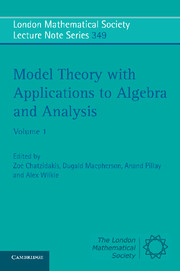Book contents
- Frontmatter
- Contents
- Preface
- Contributors
- Model theory and stability theory, with applications in differential algebra and algebraic geometry
- Differential algebra and generalizations of Grothendieck's conjecture on the arithmetic of linear differential equations
- Schanuel's conjecture for non-isoconstant elliptic curves over function fields
- An afterthought on the generalized Mordell-Lang conjecture
- On the definitions of difference Galois groups
- Differentially valued fields are not differentially closed
- Complex analytic geometry in a nonstandard setting
- Model theory and Kähler geometry
- Some local definability theory for holomorphic functions
- Some observations about the real and imaginary parts of complex Pfaffian functions
- Fusion of structures of finite Morley rank
- Establishing the o-minimality for expansions of the real field
- On the tomography theorem by P. Schapira
- A class of quantum Zariski geometries
- Model theory guidance in number theory?
Schanuel's conjecture for non-isoconstant elliptic curves over function fields
Published online by Cambridge University Press: 04 August 2010
- Frontmatter
- Contents
- Preface
- Contributors
- Model theory and stability theory, with applications in differential algebra and algebraic geometry
- Differential algebra and generalizations of Grothendieck's conjecture on the arithmetic of linear differential equations
- Schanuel's conjecture for non-isoconstant elliptic curves over function fields
- An afterthought on the generalized Mordell-Lang conjecture
- On the definitions of difference Galois groups
- Differentially valued fields are not differentially closed
- Complex analytic geometry in a nonstandard setting
- Model theory and Kähler geometry
- Some local definability theory for holomorphic functions
- Some observations about the real and imaginary parts of complex Pfaffian functions
- Fusion of structures of finite Morley rank
- Establishing the o-minimality for expansions of the real field
- On the tomography theorem by P. Schapira
- A class of quantum Zariski geometries
- Model theory guidance in number theory?
Summary
Summary
We discuss functional and number theoretic extensions of Schanuel's conjecture, with special emphasis on the study of elliptic integrals of the third kind.
Introduction
Schanuel's conjecture [La] on the layman's exponential function can be viewed as a measure of the defect between an algebraic and a linear dimension. Its functional analogue, be it in Ax's original setting [Ax1], Coleman's [Co], or Zilber's geometric interpretation [Zi], certainly gives ground to this view-point.
The same remark applies to the elliptic version of the conjecture, and to its functional analogue, as studied by Brownawell and Kubota [BK], and by J. Kirby [K1]. Here, the elliptic curve under consideration is constant. In the same spirit, we discuss in the first section of this note Ax's general theorem [Ax2] on the exponential map on a constant semiabelian variety G, where transcendence degrees are controlled by the (linear) dimension of a certain “hull”. We obtain a similar statement for the universal vectorial extension of G, and refer to the recent work of J. Kirby [K2, K3] for further generalizations of Ax's theorem, involving arbitrary differential fields, multiplicative parametrizations, and uniformity questions.
The naïve number-theoretic analogues of these functional results, however, are clearly false. The first counterexample which comes to mind is provided by periods: Riemann-Legendre relations are quadratic, and cannot be tracked back to hulls of the above type.
- Type
- Chapter
- Information
- Model Theory with Applications to Algebra and Analysis , pp. 41 - 62Publisher: Cambridge University PressPrint publication year: 2008
- 6
- Cited by



